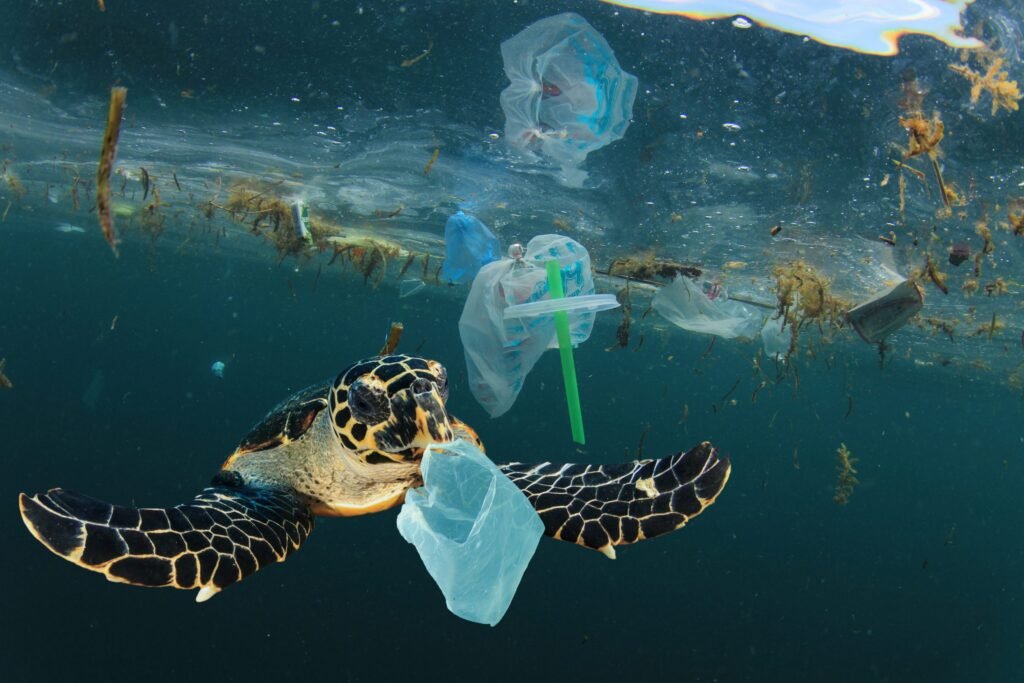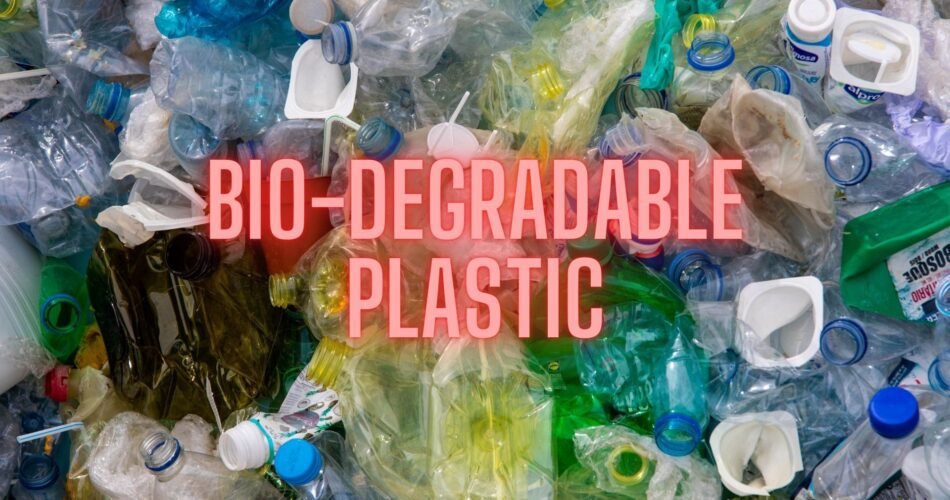This blog provide information about Biodegradable Plastics. We started the blog with the definition of Biodegradable plastics. Then will discussed about why plastic is harmful. After that we discussed the difference between Conventional and Biodegradable plastics. Then we talked about Different Biodegradable plastics. And in the end we discussed the Applications of Biodegradable Plastics. We basically learnt about the topics Biodegradable and Conventional Plastics.
Definition of Biodegradable Plastics:
Biodegradable plastics are those, that can be degraded by the action of living organisms by the process of decomposition. These plastics have taken a great attention when people got awareness about the drawbacks of traditional plastics.
Biodegradable Plastics provides us the facilities same as conventional ones, but are not dangerous for our environment as they do not persist into the environment causing harm to ecosystems for years.
These plastics are able to replace conventional plastics. We can use these to make bottles, packaging, decorative material, utensils and also many other useful things.
The most important and amazing fact about these plastics are that they can be made from plants, sugars, and other commonly found natural things. So, no expensive raw material is needed for the manufacture of these plastics.
We will discuss in this blog, that how conventional plastic is harmful to us? and how biodegradable plastic is useful in many ways. We will also discuss some remedies to make biodegradable plastics that can be used by humans. We will discuss about Biodegradable and Conventional Plastics.
Why Plastic is Harmful?
Following are some of the reasons why plastics are harmful for living organisms:
1: Non-biodegradable:
The most biggest drawback of traditional plastics is that they are non-biodegradable, so as they cannot be degraded by natural processes and persist in or environment for years. Their existence cause harm to the environment for hundred of years. It pollutes all the ecosystem in different ways and so it even make them poisonous to some extent. In this way it keeps harming the environment year by year.
2: Microplastics:
New research suggests that we breathe plastic, we drink plastic and we eat plastic. This means that if plastic exist in our environment, it spread through the winds, water, eatables and in short every part of the environment. These microplastics travel through the environment to our food chains and then enters to our body parts, causing different diseases and organ damage as long term effect.
3: Harmful diseases:
Plastics in our environment is cause of many harmful disease such as cancer, allergies, asthma etc. in humans and even animals. The microplastics can accumulate in your body parts and also cause damage to them leading of fatal health conditions and diseases. These also cause harm to the aquatic species and marine life by causing damage to their organs and breathing mechanisms.
4: Death of Animals:
Plastic pollution is the cause of death of animals worldwide. Straws, bottle caps, plastic bags and other single-used plastics are cause of death of millions of animals in water and also on land. Their death cause by choking, blocking ways, stuck on their beaks and many other consequences. Some small animals may stuck into the plastic bags or wrappers and die due to choking.
5: Ocean Acidification:
Ocean acidification is the rise in acidity and lowering of pH of the ocean. This can be because of plastic pollution in the ocean. Plastic pollution emits different acids and microplastics that adds into the acidity of ocean. It cause damage of small ecosystems, protective shells and coral reefs into the ocean. That is why plastic pollution is the main reason of ocean acidification.
These are the reasons why plastic is harmful for living things.

Difference Between Conventional Plastics and Biodegradable Plastics:
Conventional Plastics:
These plastics are made from non-renewable resources such as petroleum and natural gas.
Plastics of this type are non-biodegradable plastics and also persist in the environment for years.
These are very harmful for our environment in every way.
This plastic is fully made of chemicals that cause addition of chemicals to the environment.
It cause higher emissions of Green House Gases in their production.
Conventional plastics are difficult to recycle or destroy.
It has low production cost than Biodegradable plastics.
Vs
Bio-degradable Plastics:
These plastics derive from renewable sources, such as plants, microbes etc.
Plastics that are biodegradable can be decomposed earlier than other plastics by natural activities of decomposers present in the environment.
These plastics are eco-friendly and do not harm the environment.
No chemicals use in their production.
It emits lower concentrations of Green House Gases in their production.
They can be recycled and reused in our environment.
It has a higher cost of production than conventional plastics.
The only drawback of biodegradable plastics is that, they have a high production rate. But in my opinion, this production rate is not expensive than destroying our environment with conventional plastics. So, we must replace it with biodegradable plastic in order to restore our ecosystem.
Different Biodegradable Plastics:
Following are different Biodegradable plastics:
Sugar-based Plastics:
We can make plastics from sugar. A person made home-made biodegradable plastic with the help of water, sugar and glycerin. This was cooked at high temperature and was spread over silicon paper and dried for 2 to 3 days or for 6 hours into the oven. This technique provide us with a strong plastic-like material completely made with sugar. By taking guiding light from this technique we can find out more ways to produce sugar-based plastics.
Plant-based Plastics:
In plant-based plastics, we commonly use plant-based molecules to produce plastics. The plants used in the manufacture of plant-based plastics are as follows:
Sugarcane
Algae
Corn
Wheat
Food waste etc.
We can use all of these to make biodegradable plastics as they will provide no harm to the environment and merge into the environment just as they were once part of it. Their wastes provides fertility to the soil and are easily degraded by bacterial activity in a short time.
Animal-based Plastics:
Do you know? We can utilize dead bodies of animals in order to make biodegradable plastics? Yes, we can. We can utilize the protein and lipid structures of animals to form biodegradable plastics. These plastics will be eco-friendly and also will not harm the environment in any way. We can utilize dead organic matter to create ecofriendly plastics for human use.
These are the few Bio-degradable Plastics.
Applications of Biodegradable Plastics:
Following are some applications of Biodegradable plastics:
Plastic Bottles:
As we know that we use hundreds of plastic bottles everyday for different purposes. Such as Shampoo bottles, water bottles, skin care bottles etc. If we replace these bottles with biodegradable plastic, so we could get rid of microplastics that we breathe, eat and drink everyday.
Kitchenwares:
We eat and drink in conventional plastic containers. And even we save our leftover food in plastic containers so if we replace these containers with eco-friendly plastic, we can get rid of plastic and microplastics everyday with every meal of the day.
Shopping Bags:
When we go into the market, we see plastic bags everywhere. We buy our fruits and vegetables in plastic bags and make our food poisonous. The biodegradable plastic bags will help us to avoid poisoning our own food and also making it fit for us to eat.
Disposable Table ware and Utensils:
We can replace conventional plastic’s disposable table wares and utensils with safe and biodegradable material, so that we can get rid of the waste very easily and it can be degraded in a short time after usage. We should apply it on domestic as well as bigger level.
By replacing these products with biodegradable plastics we can have a safer environment to live in and we can take part awareness of the people and so restoring of our ecosystem.

Conclusion:
Biodegradable plastics are those plastics that can degrade by natural activities of microorganisms and do not persist in the environment just as conventional plastics. The most important fact about biodegradable plastic is that it is highly eco-friendly and cause no harm to the environment but in return provide nutrients to the environment. We discusses the difference between Conventional and Bio-degradable plastics. Then we discussed applications of biodegradable plastics. To learn more about plastic pollution read our Blog Plastic Waste Management. We studied details about Biodegradable and Conventional Plastics.
To learn about more topics, click the links below:


Comments